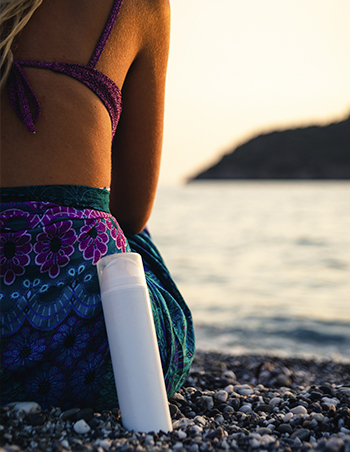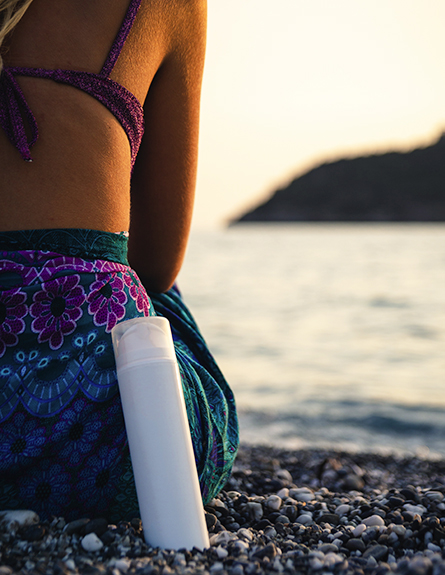
How to protect your skin with non-toxic SPF | Sunscreens for Every Season
Date: 07/29/2022
In these hot summer months, beachgoers who don’t wear sunscreen will be quick to tell you all the reasons they don’t wear it. Perhaps you’re one of them…just like me (haha)! The common denominator, it seems, is because a lot of sunscreens on the market today contain toxic chemical formulations we should avoid.
The thing is, they (or you) are not entirely wrong! There have been several surveys and studies which speak to the toxic components used in most commercially available sunscreens today.
If you’ve followed me long enough, you’ll know I have a pretty strong stance on choosing non-toxic personal products in general. We should all be researching what we put into and onto our bodies.
However, as sunscreen studies have shed new light on what’s dangerous to humans, and to our long-term skin health, some sunscreen brands have formulated sunscreens and SPF agents that are mineral (as opposed to chemically) based.
With more natural components, these brands are breaking new ground when it comes to eliminating toxic elements from sunscreen products.
That’s why today I want to put a positive spin on sunscreen to combat the critics. I do believe sunscreen use is important, and I want to share a little of what I know about the advantages of using sunscreen. I’ll also talk a little ‘shop’ when it comes to buying sunscreen products for yourself to answer your questions about the best sunscreens available for long-term skin health.
Should I be wearing sunscreen?
Medical professionals and related research overwhelmingly agree that the potential advantages associated with regular sunscreen use outweigh the potential drawbacks. Sunscreens are successful skin protectors, and help prevent both sunburn and premature aging.
There is also a huge body of medical research that speaks to sunscreen’s effects in decreasing the risk of skin cancer, while sunscreens have also been known to reduce the effects of increased skin sensitivity to sun (which can be caused by some medications).
Sunscreens can even reduce the incidence of skin cancer-related tumors (squamous cell carcinoma) by up to 78% over a single person’s lifetime.
The reason sunscreen works, is because active SPF ingredients either absorb certain types of UV-rays, or reflect them, preventing UV-radiation damage from being directly absorbed by DNA.
However, not all sunscreens protect against all types of UV rays, which is why you’ll see more recommendations for broad-spectrum sunscreens at about 30 SPF or higher.
Did you know? Sunscreens were initially approved as over-the-counter medications for the prevention of sunburn!
Remember though, that sunscreen is not a catch-all for preventing or reducing the short- and long-term effects of sun exposure. Dermatologists often recommend that sunscreen use go hand in hand with general sun avoidance during peak sun hours—particularly where children are concerned.
The best ways to avoid the sun, and still have fun?
“Seeking shade, wearing hats and protective clothing, avoiding outdoor activities during peak sunlight hours, and regularly using sunscreen” will help, say Dr.’s Adamson and Shinkai.
Are all sunscreens created equal?
When I think about the research I’ve come across, my instinct here is to say ‘no’—if only because sunscreens come in a variety of ‘types’. Different sunscreens can for instance be either chemical or mineral like I mentioned before. As well, the spectrum of UV protection is bound to change between brands, types, or product lines.
Let’s look at these two factors a little more closely, shall we?
Chemical vs. Mineral (or, Chemical vs. Physical)
According to this article, sunscreen ingredients can be either mineral or chemical.
Chemical sunscreen types have UV filters which absorb radiation. They “turn the [UV] light into non-damaging heat”, and use ingredients like avobenzone, octocrylene and oxybenzone to create a sheer application effect on the skin.
Mineral sunscreens have physical UV filters made up of elements such as zinc oxide or titanium dioxide. These filters work to reflect UV radiation away from the skin, though they apply slightly thicker than their chemical counterparts. Many mineral sunscreens will end up accommodating for the white residue left behind with skin-colored pigments.
Reports however admit that because of the comparatively “cosmetically acceptable” nature of chemical sunscreens – which are less likely to leave chalky residue on the skin – these are more popular with consumers, and therefore more publicly available. As of the beginning of 2020, the sun care industry in the US topped $1.95B.
Broad-spectrum vs. UVA/UVB sunscreens
As you’re going through and reading labels during your next sunscreen purchase, studies suggest you choose broad-spectrum sunscreens which ultimately provide more protection against different kinds of skin-cancer causing radiation.
On the other hand, if the label says UVA protection without UVB protection (and vice versa), you may want to skip to the next label.
In fact, you might notice as you’re going through different brands that the majority provide UVB protection only. Trends show most brands skew toward UVB protection, leaving the specifically dangerous UVA rays to get through (UVA exposure is significantly linked to melanoma).
This may be one of the reasons we’re likely to hear people argue that sunscreen causes skin cancer, since sunscreen data skews toward those who are more prone to staying outdoors for extended periods of time, and since UVA rays are not blocked.
To me, the idea that sunscreen may increase risk factors for skin cancer does bring up an interesting point that I think is worth exploring. Are the chemicals used in these sunscreens safe for our skin and skin health?
Turns out, there are some toxic chemicals in most commercially available sunscreens that you should be aware of—though admittedly some dermatologists agree that the term ‘toxic’ vs. ‘non-toxic’ can be somewhat problematic due to regulation concerns. So says MD Heather D. Rogers:
“Nontoxic and toxic are unregulated terms often used as a marketing claim without a clear definition…and unfortunately, even though it should be clear what makes something toxic, for many ingredients it is not clear, and the onus is on the consumer to decide what he or she is comfortable with.”
What kinds of toxins should I avoid while buying sunscreen? | 7 Toxic Chemicals to Avoid in Sunscreen Products
Because it is ultimately up to us to decide what chemicals concern us most, I will first mention the top three concerning chemicals that can appear in both chemical and mineral sunscreens (in mineral too?), before talking about some recent recalls on sunscreen products containing benzenes specifically, as well as about the nature of perfume additives and how they can further irritate skin.
Where sunscreen is concerned, buyers should first beware of benzophenones (additives known more to chemical sunscreens than mineral), camphor derivatives like 4-methyl benzylidene camphor or 3-benzylidene camphor, and cinnamate derivatives like octyl methoxycinnamate, isopentyl-4-methoxycinnamate, or octocrylene.
To help translate some of the dangerous effects known to these popular sunscreen ingredients, I will quickly summarize some of the main findings for each chemical from Health Web Magazine (which you can read in full here).
- Benzophenone has been known to showcase estrogen and androgen disrupting effects.
- Benzophenone studies with rats have shown disturbances to normal testosterone hormone levels during male animal development.
- Benzophenone’s are known to inhibit or inactivate critical thyroid hormone processes.
- Camphor derivatives can accumulate in skin after prolonged exposure and are easily absorbable by skin.
- Cinnamate derivatives can disrupt different hormones including estrogen, progesterone and thyroid hormones.
Nowadays, more studies are coming forward distinguishing the specifically harmful nature of popular chemicals used in sunscreens, including and beyond the above. And while extensive lists of the more dangerous additives in sunscreen products can be found online – as well as lists which detail what sunscreens to avoid specifically – here are just a few more interesting tidbits I came across during my search into the subject:
- Male fertility is known to be impacted by up to 13 of the 29 most prevalent chemicals used in most sunscreen products.
- Men with high rates of oxybenzone – also known as benzophonene-3 – in their system have increased difficulty of getting a woman pregnant.
- Hawaii was the first state to ban oxybenzone in sunscreens in 2018, and later octinoxate in sunscreens in 2022. Key West in Florida also banned these two chemicals in 2019.
Another dangerous chemical you are going to want to watch out for is benzene—though this chemical is not likely to be listed on the label of the bottle you’re buying.
That’s because most benzene levels in sunscreen products are caused by contamination as opposed to direct usage or addition during the manufacturing process. With prolonged exposure, benzene is known to impact cancer risk, and is listed as a reproductive toxin.
So how can you avoid benzene in your products? My suggestion is to keep a close watch on recalls, and again to find resources or products which have an ethical outlook on skin protection and sunscreen manufacturing.
That said, two things you can more easily avoid as you begin to shop around for a sunscreen that suits you are perfumes/fragrance and nano-particle sunscreen formulations.
Perfumes/fragrances are easy enough to avoid, and are often a primary cause of skin irritation in most skin care products, including sunscreen. The trick is to look for unscented, fragrance-free sunscreens to avoid perfume related skin irritation.
Nano-particle sunscreen formulations (either nano zinc oxide or nano titanium dioxide) on the other hand, have been found to actually accelerate the aging process of your skin, and are (scientifically-speaking) not exactly optimal for human use.
And while they make the sunscreen you use apply more smoothly, and with less white residue, they end up putting your skin under oxidative stress in response to heat—that is, if the sunscreen manufacturer hasn’t added aluminum or silicone to the nanoparticles for protection.
Nano titanium dioxide has also been linked to fetal blood flow issues for pregnant women, while nano zinc oxide has a correlative relationship with mitochondrial damage.
To be clear, you’re more likely to find these combinations in mineral sunscreens than chemical—where another benzophonene (avobenzone) is usually added to provide broad-spectrum protection. Research advises to stay away from this chemical as well, since it degrades when exposed to UV rays…meaning other active (potentially harmful) ingredients must be added to keep the formulation stable.
To summarize then, here are the top 7 chemicals to avoid when shopping around for a skin-safe sunscreen:
- Benzophenone and benzo derivatives (avobenzone, oxybenzone)
- Camphor derivatives
- Cinnamate derivatives
- Benzene
- Perfume and fragrance additives
- Nano zinc oxide sunscreen formulations
- Nano titanium dioxide sunscreen formulations
PLUS, here is one of the most comprehensive lists of sunscreens to buy based on their safety, as well as which to avoid while you’re considering sunscreen safety for you and your family.
How do I know which sunscreen is best for my skin health?
The FDA has admitted there is a lack of scientific evidence surrounding the safety of any sunscreen ingredients aside from non-nano titanium oxide and zinc oxide.
Per regulations implemented in 2019, then, the FDA has updated sunscreen-related regulations per 16 active ingredients and their relative safety for human use in creams, sprays, gels, and other sunscreen products:
Again, the only safe and effective ingredients are zinc oxide and titanium oxide.
The unsafe, though effective, ingredients include PABA and trolamine salicylate.
Echoing the research I mentioned above, chemicals additives with insufficient data for testing are oxybenzone, avobenzone, cinoxate, homosalate, octinoxate, octisalate, octocrylene, dioxybenzone, ensulizole, meradimate, padimate O, and sulisobenzone.
Knowing which chemicals to avoid is of course only part of the story. Now, it’s important to understand which sunscreen properties improve sun care, and which positively impact the health of your skin.
For example, I found this awesome article which speaks to the efficacy of popular seed oils and their potential as natural UV filters which aid in the repair of damaged skin cells. Oils like pomegranate seed oil, castor oil, cocoa butter, jojoba oil, rosehip oil, grapeseed oil, kenaf seed oil, and even pumpkin seed oil have been found to have beneficial properties when added to sunscreen formulations. Positive effects are in fact attributed to the anti-oxidant, anti-aging, and anti-flammatory nature of these seed oil types.
Another potentially beneficial addition to sunscreen formulations are associated with other popular anti-oxidants. Some studies show, for example, that added anti-oxidant vitamins like caffeine or echinacea have reduced sun damage effects when used in sunscreen products. On the other hand, vitamin A derivatives known to most ‘anti-aging’ cosmetics can be harmful when added to sunscreen formulations, as they may “speed the development of tumors and lesions on sun-exposed skin”, so be wary of those!
In sum, you should be buying mineral-based broad-spectrum sunscreens with non-nano zinc oxide or non-nano titanium oxide additives as the main sun care ingredient. Avoid perfumed or scented sunscreens, but indulge in ones with anti-oxidative properties from seed oils or other botanical vitamins.
What sunscreens should I buy?
As I mentioned, there are some great lists online which have done extensive product research into different brands, so my best advise is to do a little research to find which products appear in the ‘safe’ category across the board before you get to buying.
To start, here is a link to my favorite list (scroll to the end of the article) of safe and non-safe sunscreens:
Best Non-Toxic Sunscreens (& Ones to Avoid) in 2022
Otherwise, I do have a few brands that I love personally, and would absolutely recommend to those who are looking for a great sunscreen that hits all the safety aspects I talked about above. To be clear, I haven’t been paid to advertise for these brands, they’re just the brands I personally have tried and continue to use.
Here’s a quick list of my top 5 favorite sunscreen brands:
- 100 Percent Pure Sunscreen
- Marie Veronique Tinted Sunscreen
- Babo Botanicals (great for kids)
- Suntegrity Tinted Sunscreen
- Le Prunier Sunscreen
(If you’re wondering, I use the suntegrity tinted sunscreen every day!)
Sunscreen for every season!
Most dermatologists agree that the real measure of a sunscreen’s effectiveness is the extent to which it reduces DNA damage, free radical generation from UV rays, and immune system suppression…all dangerous pre-cursors to skin cancer.
Still, most of us want to be wary of the actual care products we’re using to make sure they’re not doing more damage than good in the long-run!
Hopefully this article has given you some simple insights on what kinds of sunscreens you should avoid, and which are best for you and your family. Again I can’t impress enough how important it is to wear sunscreen anytime you’re going into the sun, particularly when you plan to be in and out of the water.
I also recommend you wear sunscreen in every season…winter and cloudy days are no exception! Use lighter formulations in the summer, and heavier, creamier, and more moisturizing sunscreens during dry winter months (if your skin type allows it).
With that, I leave you to continue your sun care research journey, and to check out other great articles, customer reviews, and forums before you commit to a new product. The best part is you can shop for most products today without having to step foot in the sun, so sit back with a hot tea this evening and get shopping!
As always, let me know what you find, and send me pics of you enjoying yourself in the summer sun with your new sunscreen!
Xo, ![]()
Lena
SUBSCRIBE
Get the latest updates, sneak peeks and more.
 Back To All Posts
Back To All Posts Previous Post
Previous Post

